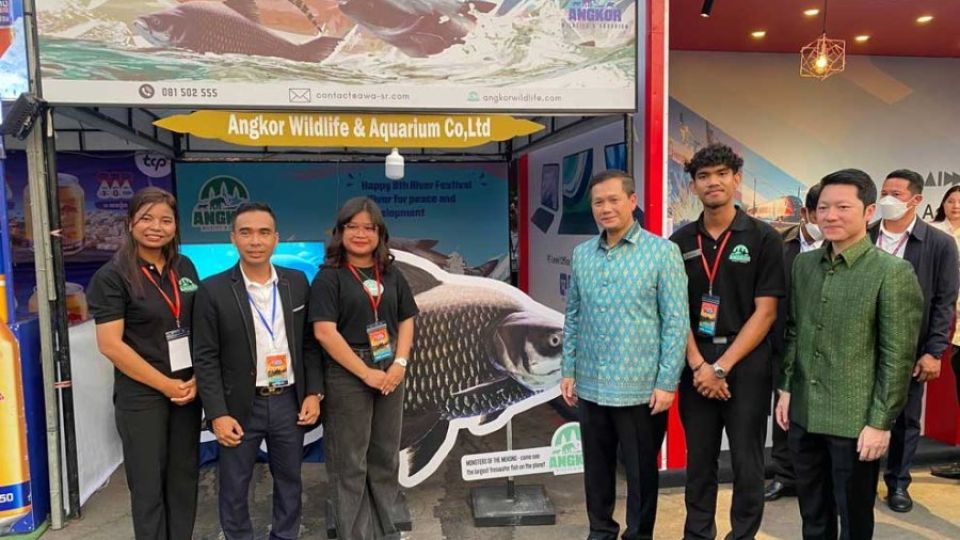March 28, 2024
PHNOM PENH – Two tourists in Siem Reap were seen chatting with smiles on their faces, intrigued by the numerous species of fish swimming in glass display tanks, while other visitors took photos and enjoyed watching.
Visiting the Angkor Wildlife & Aquarium offers a distinctive experience from the usual temple visits, beaches and crowded exhibitions. The facility in Siem Reap town and province features an exhibition of freshwater fish, animal parks and a reptile enclosure.
This unique opportunity to relax is quite different from conventional tourist offerings.
Many visitors from across the country made a stop at the aquarium during the 8th River Festival held in Siem Reap from March 15-17.
The aquarium is situated in Sotr Nikum district’s Khchas commune, about 30km from the provincial town.
Upon entering the exhibition area, visitors expressed elation and surprise at seeing a diverse range of freshwater fish species, primarily from the Mekong River, giving the impression of being on the riverbed.
“This was my first time visiting here. It’s really strange to see the fish in the display tanks here. It felt like I was diving down to the river and sea beds, and I felt like I was one of the fish swimming with them,” says Samnang Thearith, a 30-year-old visitor from Battambang province.
He remarks that the information officers were friendly and attentive, providing detailed explanations about the various species. He describes the visit as a unique recreational experience that many people have yet to discover.
Chhay Dany, a 16-year-old girl from Kampong Cham province, shares her joy of visiting the seabed biodiversity exhibition with her parents.
“As I walked into the seabed exhibition site, I felt even more amazed than at the riverbed exhibition. Seeing corals, fish and other sea animals made it seem as though I was part of the story,” she says.
Chhay Dara, a 32-year-old from Kampot province, expresses his enthusiasm about taking photos at the venue. He encountered wildlife he had only heard about but had never seen conserved and cared for before.
“Apart from the river and sea views, I was fascinated by some wild animals, like Malayan pit vipers [Calloselasma rhodostoma], which I have never seen or heard of before. There were also endangered wild animals on display,” he says.
Over 100 species showcased
Ol Vanda, general manager of the facility, reveals in a recent interview with reporters from the Club of Cambodian Journalists (CCJ) that the aquatic park is home to over 120 species of animals, including 50 varieties of wildlife, 30 sea and more than 40 freshwater species.
He emphasises that the park’s purpose is not to acquire animals for display, but to offer habitats where they can lead better lives, especially if they are sick or endangered.
“When we rescue endangered species, we have to release them at the Siem Pang Wildlife Sanctuary [in Stung Treng province], as it offers a safe habitat for them,” he adds.
According to Vanda, entrance fees are $11 per adult national visitor, $5.50 for children and $20 for foreigners. Additionally, the park offers special packages for educational group tours from schools, costing only 10,000 riel ($2.50) per person.
He notes that the park attracts approximately 500 to 1,000 visitors daily, mostly Cambodians, with some foreign visitors.
“This is the first place in Cambodia to exhibit such biodiversity, and we are open to everyone, young and old, local and foreign, albeit at different prices,” he says.
The park currently employs 140 local residents. With continued support from both Cambodian and international visitors, it is set for further expansion.
Vanda notes that development plans currently allocate $70 million for enlarging the park to cover 100ha of land. At present, it encompasses only 10ha.
Pat Pov, a 35-year-old resident of the province’s Puok district and a security guard at the park, shares his experience of working there over the past year.
He highlights the pleasant environment and decent salary, an improvement from his previous job.
“With this investment, more local residents have found employment. It’s beneficial and has created numerous jobs in our village. Further expansion of this place will provide even more employment opportunities,” he adds.
Sous Srey Leap, a 21-year-old information officer at the entrance of the park, was an exchange student from Battambang, pursuing a bachelor’s degree in Siem Reap. She applied for the job last year to support herself.
“The work here is rewarding and provides extensive knowledge about animals and fish,” she says.
The English literature student expresses her happiness about the park being the first of its kind in the country, offering significant research benefits.
“It’s particularly useful for the younger generation who wish to gain a deeper understanding of different species,” she adds.


